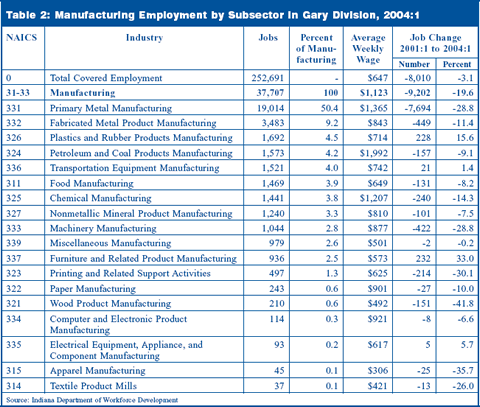The Gary Metro Division
The Area (View map of region)
More than one out of every 10 Hoosiers lives within the Gary Metropolitan Division, which consists of four counties in northwest Indiana: Lake, Porter, Jasper and Newton. The five biggest cities in the region include Gary, Hammond (the fifth and sixth largest cities in the state), Portage, East Chicago and Merrillville.
Metropolitan divisions did not exist prior to the 2003 redefinition of statistical areas. Now, however, a metro area containing a single core with a population of 2.5 million or more may be subdivided to form smaller groupings of counties known as metropolitan divisions. Thus, northwest Indiana was absorbed into the Chicago-Naperville-Joliet, IL-IN-WI metro area, which was then divided into metro divisions (see Figure 1).
The four-county Gary metro division had a 2003 population of 685,490, a 1.4 percent growth since Census 2000. This is slightly less than experienced in the state overall (1.9 percent). Porter County added over 5,700 residents, advancing 3.9 percent. This was nearly twice the number of people added in Lake County, which grew only 0.6 percent. Jasper County added just over 1,000 people for a 3.4 percent growth. Meanwhile, Newton lost 163 residents, declining by 1.1 percent.
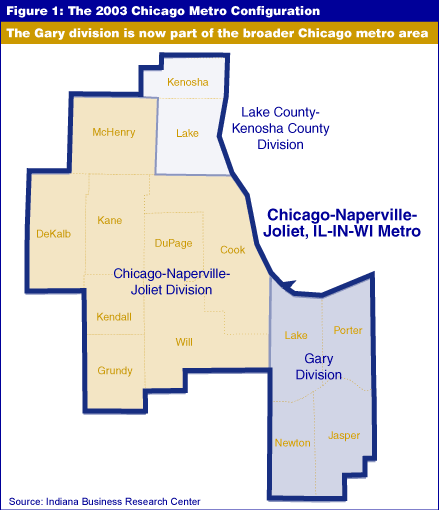
Over 70 percent of the metro division’s population lives in Lake County (see Table 1), which is also one of Indiana’s most diverse counties. Over 25 percent of the population is black, and it has the largest number of Hispanics of any county in the state. (Bear in mind that Hispanic is not a race but an ethnicity, so it is calculated separately.) In fact, the 70,602 Hispanics living in the Gary metro division account for nearly 30 percent of all Hispanics statewide.
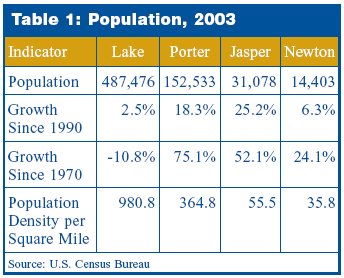
Projections from the Indiana Business Research Center indicate that the Gary region will continue to grow, although at a slower pace than the state. By 2020, the division is set to gain about 16,000 people from current levels, an increase of 2.4 percent, while the state is projected to grow 8.8 percent.
Industrial Mix and Jobs
Manufacturing accounted for 14.9 percent of the metro division’s employment in the first quarter of 2004, down from 18 percent in the first quarter of 2001. While still the largest industry in the region with 37,707 jobs, it declined by more than 9,000 jobs since early 2001. Newton County relies most heavily on manufacturing, since the sector accounted for almost one out of three jobs in the first quarter of 2004.
Primary metal manufacturing (the steel mills) is by far the largest subsector in the Gary division, accounting for half of all manufacturing employment in the region. As shown in Table 2, that subsector lost the most jobs on a numeric basis (and accounted for 83.6 percent of manufacturing’s employment declines), but other smaller subsectors were hit harder from a percentage basis.
According to Donald Coffin, an economist at Indiana University Northwest, manufacturing employment in the region is likely to hold its own in 2005. The merger of ISPAT-Inland with ISG (to form Mittal Steel) is unlikely to have immediate consequences, as long as steel demand remains strong. (1)
Health care and social services (34,484 employees) is the next largest industry after manufacturing. Between the first quarters of 2001 and 2004, this sector had the largest numeric growth among the major industries in three of the four counties, adding 2,894 jobs region-wide.
The third biggest sector is retail trade at 32,233 employees. According to the most recent Manpower employment survey for the first quarter of 2005, the retail sector is the only sector in the region anticipating more job cuts than job gains. Nevertheless, in northwest Indiana’s overall economy, just 17 percent of employers plan to hire this quarter, down from 40 percent last quarter.
Wages and Income
Average wages for 2003 ranged from $26,255 in Newton County to $33,820 in Lake County. Figure 2 illustrates how wages in each county have changed in the past 10 years. While Lake and Porter counties still have the highest wages in the region, the loss of high-paying manufacturing jobs is one factor causing wage growth to stagnate. In both counties, the average manufacturing wage exceeded $55,000 in 2003, higher than that in adjacent counties and the state. That’s over $20,000 higher than health care and social services wages, which is the sector experiencing the most growth. This is also why Newton County did not experience the same stagnation in growth of wages, despite its higher reliance on manufacturing. Because the average manufacturing wage in Newton County is less than $30,000, the wage gap between manufacturing and other sectors is much lower.
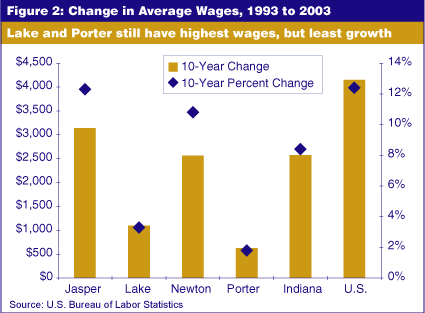
Per capita personal income (PCPI) in the Gary metro division was $27,501 for 2002, or $531 less than the state average. PCPI ranged from $22,701 in Newton County to $30,892 in Porter County (see Figure 3).
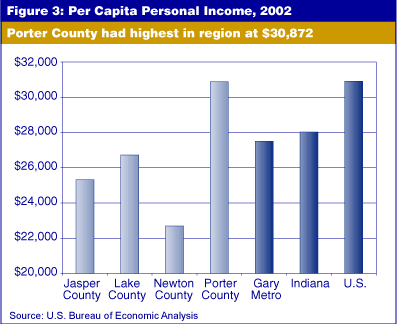
Housing
The Gary region has seen a drop in the percentage of single-family building permits over the past decade. In 1993, single-family permits accounted for 88.3 percent of all residential permits issued; by 2003, this figure had dropped to just 75.4 percent (see Figure 4). Lake County is driving this change, with just 67.9 percent of its new residential permits classified as single-family in 2003. Other counties in the region have seen increases in this percentage, indicative of increased suburbanization.
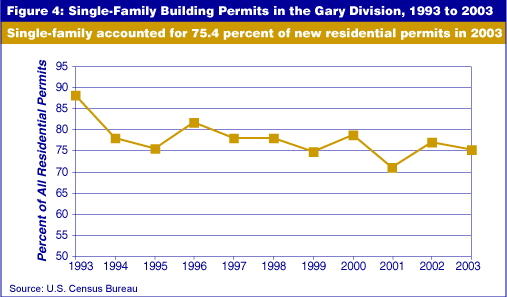
Despite declining numbers of new single-family homes, the region experienced record-breaking existing single-family home sales in 2004. According to the Times of Northwest Indiana, sales during the first 11 months of 2004 were 6.9 percent higher than the same period in the previous year. And while the tax reassessment in Lake County has hurt some neighborhoods, the housing market has remained strong overall. (2)
Notes
- For more of Professor Coffin’s analysis and projections for the coming year, see his article in the Indiana Business Review’s Outlook 2005 edition; available online at www.ibrc.indiana.edu/ibr/2004/outlook05/gary.html.
- Keith Benman, “Northwest Indiana Region on Track for Record Year in Housing,” Times of Northwest Indiana, 30 December 2004.
Rachel Justis
Managing Editor, Indiana Business Research Center,
Kelley School of Business, Indiana University

